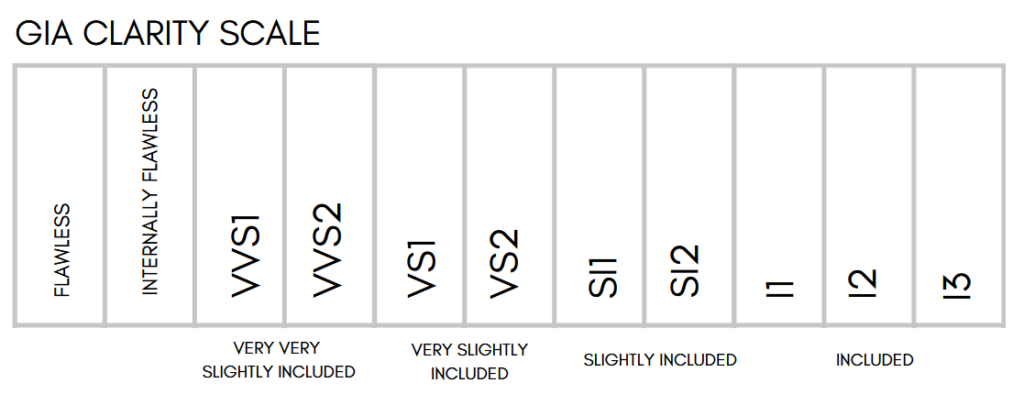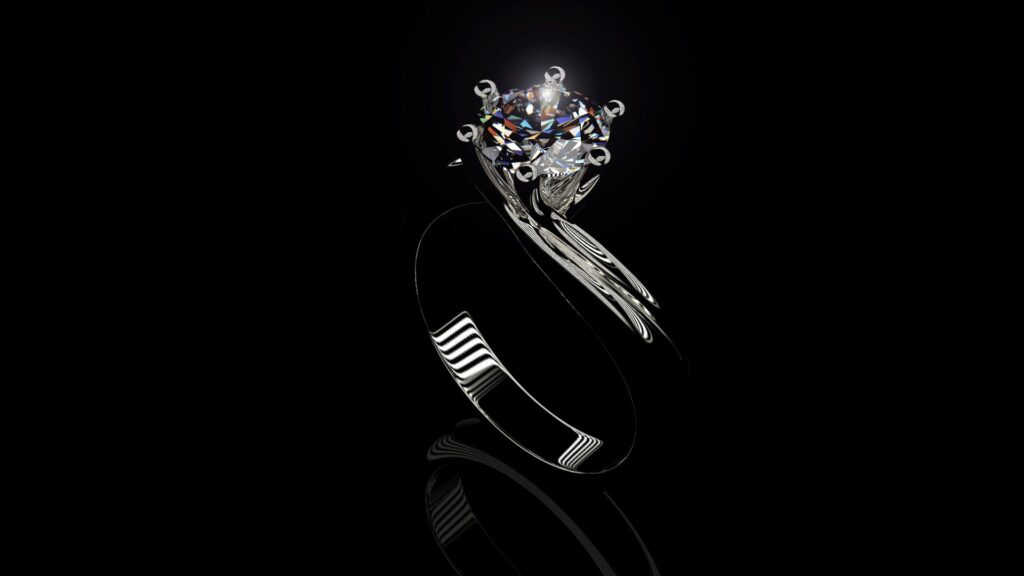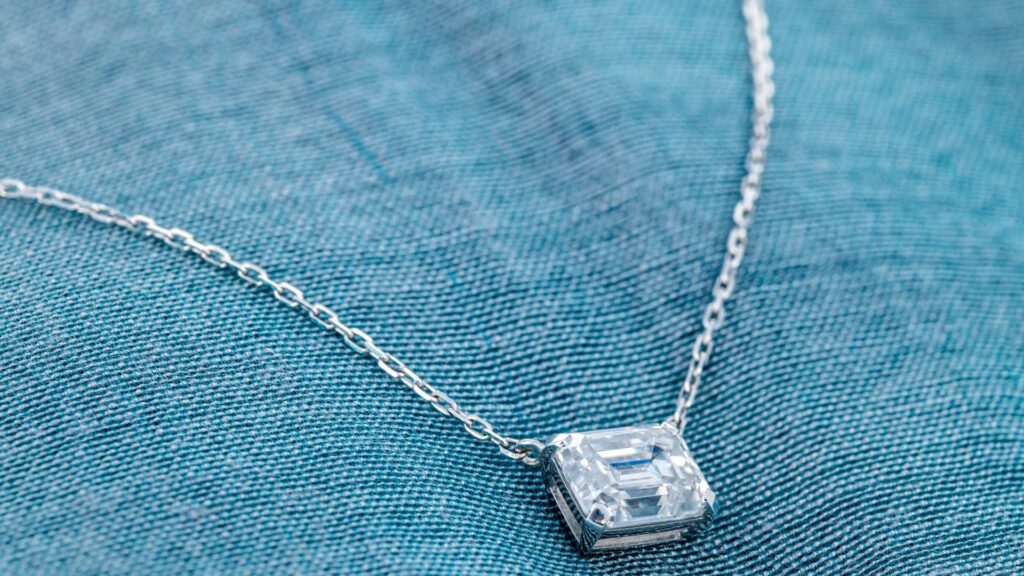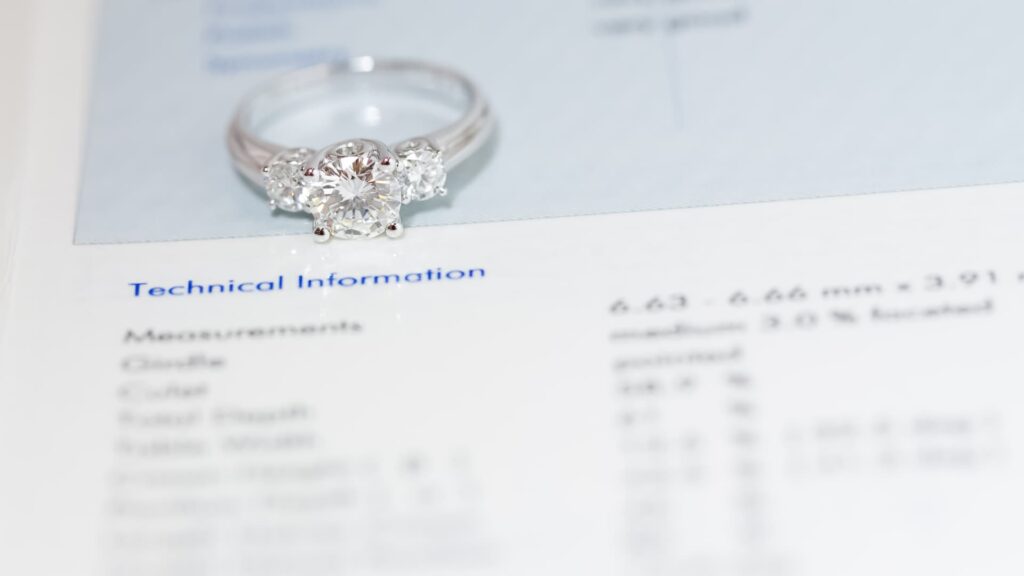While it is true that all 4 C’s of a diamond have a significant impact on its appearance, clarity is something that should never be overlooked. The clarity of a diamond is affected by inclusions and blemishes. The lesser these inclusions, the higher the clarity grade of the diamond will be.
However, it is important to note that the amount of the inclusions is not the only thing that decides the clarity grade. In fact, the type, relief, size, and location of the inclusions are also the major determinants.
The industrial standard for measuring the clarity of a diamond is the GIA clarity scale, with the highest grade being F (Flawless) and the lowest I3 (Included). Here’s how it looks:

The inclusions and blemishes in higher clarity grades are only noticeable under intense magnification. But as the grade drops, the inclusions become more and more prominent, even for the naked eye.
So here we’ll be comparing two clarity grades of a diamond: A ‘Very Slightly Included-1st Degree’ diamond and a ‘Very Very Slightly Included-1st Degree’ diamond.
Without further ado, let’s find out what these clarity grades tell about a diamond’s appearance!
What is VS1 Diamond?
Diamonds with a VS1 clarity grade indicate that they are very slightly included. It means that the inclusions or blemishes in VS1 graded diamonds are barely noticeable.
Even under a jeweler’s loupe, you will not be able to identify inclusions at first glance, and it will take multiple scans for an untrained eye to be able to spot a visibly blemished or included area.
Therefore, it simply means that these inclusions will hardly be noticeable by an unaided eye. The most common type of inclusions found in a VS1 diamond are:
· Feathers
· Indented natural
· Knot
· Crystal
However, other types of inclusions can also be spotted. The size, nature, or location of these inclusions can vary largely, yet if their effect on the diamond’s performance is similar, the diamond will be graded as a VS1 diamond.
Here’s how the GIA report of this 2ct. Emerald-Cut VS1 Diamond looks:
You can see that there a quite a few inclusions in this VS1 diamond.
To sum up and make it more clear to you, let’s see how GIA defines the ‘Very Slightly Included’ clarity grade:
“Inclusions are minor and range from difficult to somewhat easy for a skilled grader to see under 10x magnification.”
What is VVS1 Diamond?
A VVS1 clarity grade stands 3rd on the GIA scale, preceded only by ‘Flawless’ and ‘Internally Flawless’ grades.
A VVS1 diamond means that it is very, very slightly included to the 1st degree. In these diamonds, the inclusions or blemishes are quite hard to spot, even under 10x magnification.
In fact, it won’t be wrong to say that only a diamond expert or skilled grader will be able to detect the inclusions even under the jeweler’s loupe. An untrained eye will quickly fail to find out any problem spots in the diamond.
The inclusions in a VVS1 diamond generally do not have a huge impact on the diamond’s performance. The most commonly found inclusions in a VVS1 diamond include but are not limited to:
· Clouds
· Needles
· Pinpoints
Oftentimes, these inclusions are quite small or spotted at locations that render no problematic impact on the diamond.
This is what the GIA report of a 2ct. Emerald-Cut VVS1 diamond looks like:
If you compare it to the report of the VS1 diamond, you’ll notice that the inclusions and blemishes are barely there.
In short, a VVS1 diamond has inclusions or blemishes that are too hard to notice under magnification, let alone an unaided eye.
Let’s put it this way: A naked eye will not be able to discern between a flawless and VVS1 diamond.
Here’s how GIA defines the ‘Very Very Slightly Included’ clarity grade:
“Inclusions are difficult for a skilled grader to see under 10× magnification.”
What is the difference between VS1 and VVS1 diamonds?
The VS1 clarity grade of a diamond stands two places below the VVS1 grade which means both of them obviously are different. So let’s take a look at a few primary factors that set them apart from each other.
VVS1 Inclusions are Difficult to Spot
A VVS1 clarity grade is just two spots down from the finest and most flawless clarity grade for a diamond ‘F.’ This makes these diamonds pretty close to being flawless. As you can tell by the name, these diamonds are very, very slightly included.
The inclusions or blemishes in a VVS1 diamond are quite difficult to spot, even for a skilled diamond grader under 10x magnification. And to the naked eye, the diamond will look absolutely flawless.
Whereas spotting inclusions and blemish spots in a VS1 diamond using a jeweler’s loupe is fairly easier than a VVS1 diamond.
Even an untrained person will be able to detect the inclusions in a VS1 diamond after a few scans, unlike the VVS1 diamond, which is hard to examine even for a trained professional.
VVS1 Diamonds are Less Included
Before I proceed with this point, I’d like to clarify the fact that the amount of inclusions is never definite for any clarity grade except for the ‘Flawless’ diamonds, which have no inclusions or blemishes either.
But as a general observation, most of the time, VVS1 diamonds have lesser inclusions than VS1 diamonds. Or you can say that the inclusions in a VS1 diamond affect the performance of a diamond to a greater extent, even if they’re in a smaller number than VVS1 inclusions.
I started off with the disclaimer because, at times, you may come across VVS1 diamonds that have a greater number of inclusions than a single but more impactful VS1 inclusion.
VS1 Inclusions are More Impactful
The inclusions in a VS1 diamond are far more impactful on the appearance and performance of a diamond than VVS1 inclusions.
This means that a VS1 diamond may have the same or a lesser amount of inclusions on its surface than a VVS1 diamond, but it will have a greater effect on the brilliance and durability of a diamond.
The location of inclusions or blemishes in a diamond has a significant impact on its longevity. If the VS1 inclusions are around fragile areas, the diamond will be more at risk of breaking or chipping.
Anyway, this is not to say that a VS1 diamond is not durable. It sure is. But the inclusions in these diamonds have a greater impact on the diamond’s performance than the VVS1 inclusions.
VVS1 Diamonds are More Expensive
With standing closest to the flawless graded diamonds, a VVS1 diamond is, of course, more expensive than a VS1 diamond.
As you move down the clarity scale, the price of the diamond will decrease, given all other features remain the same.
So if you’re going to purchase a VVS1 diamond, then know that you’ll have to pay more for its qualities, mainly less visible and less impactful inclusions.
VS1 vs. VVS1: Which One Is Worth It?
Here comes the real question. So, which of these clarity grades is the best option?
Well, there is a variety of factors that can impact the answer to this question. Both of them can prove to be great options in different situations.
A VVS1 diamond is, of course, superior to the VS1 diamond, but the naked eye can hardly distinguish between them, especially if your diamond is less than 1.5 carat.
A 1.5-carat or more petite diamond with a VS1 clarity will look flawless to an unaided eye. That is because the size of this diamond is not big enough to make any inclusions or blemishes prominent.
Look at the images of diamonds from James Allen. Can you spot a difference? Probably not
Anyway, if you’re going for a diamond with a carat weight higher than that, VVS1 clarity will be a better option, without a doubt. A higher carat and hence, bigger in size diamond will easily reveal the VS1 inclusions.
Therefore, to be on the safe side, go for a higher clarity grade if you’re going for a bigger diamond. A VVS1 diamond is a great choice if you’re willing to pay the premium price for something that won’t make a lot of difference without that 10x magnification.
To sum up, I’d say that there’s no definite choice that can be made in this regard. The best decision can be made by a side-by-side comparison of the diamonds. If both look eye clean, then go for the one that costs you less and avoid overpaying for a feature that only makes a difference on the paper.
Price Comparison: VS1 vs. VVS1
So it is quite obvious by now that a VVS1 diamond will cost you more than a VS1 diamond based on the difference in amount, nature, and impact of inclusions.
A VVS1 diamond is considered more valuable because it is close to flawless. The lower the clarity grade, the lesser the price will be. And that’s not only in the case of clarity but all other C’s of the diamond as well.
Anyway, we’ll be making a quick comparison between the prices of VVS1 and VS1 diamonds from our topmost recommended vendors, James Allen and the Blue Nile. So let’s get into that.
We’ll be taking a one ct. Round Ideal, G color diamond in consideration. With a VVS1 clarity, this diamond will cost you around $7300, but if we change the clarity to VS1, it’ll save you around 800 bucks at a price of $6500.
The prices of 1ct Round Ideal, G, VVS1 diamonds at James Allen start from $7300 and can go up to $10,900. Whereas the prices of diamonds with similar features but with a VS1 clarity start from $6500 and go up to $10,200.
Similarly, if we take a look at the Blue Nile diamonds, the price difference is quite the same. The prices of 1 ct. Round Ideal, G, VVS1 diamonds start from $7600 and go up to $12,200. At the same time, the prices of similar diamonds in a VS1 clarity grade start from $6800 and go up to $11,000.
The price difference increases as the carat weight increases. For instance, this 2ct. VS1 diamond is priced at $25,166, whereas a 2ct. VVS1 diamond can fetch a price up to $36k and higher.
Is VS1 and VVS1 Diamond Eye Clean?
Eye cleanliness of a diamond refers to the fact that it doesn’t show any visible blemishes or inclusions without magnification, i.e., it appears flawless to the naked eye.
The eye cleanliness of diamonds is not linked to particular clarity grades. Of course, higher clarity grades will most definitely be eye-clean, but you can find eye-clean diamonds in lower clarity grades such as VS2 or even SI1 at times.
Finding eye-clean diamonds in lower clarity grades can be a huge steal. So if you’re looking to save your hard-earned money, strive to find out eye-clean diamonds in lower clarity grades. Because at the end of the day, the diamond will be looked at by an unaided eye and not under the jeweler’s loupe.
But as for the initial question, yes, VS1 and VVS1 diamonds are both eye-clean.
Final Verdict
Differences between a VS1 and VVS1 diamond are generally almost impossible to find for an unaided eye. Some people may even think that the difference between these two grades exists only on the paper, and well, that is correct to some extent. However, these differences in the paper can impact the diamond’s performance in the long run.
Related articles:
VS1 vs. VVS2 Diamond Compared






